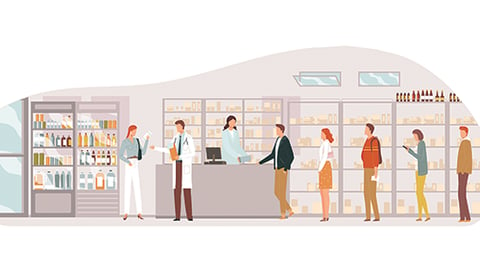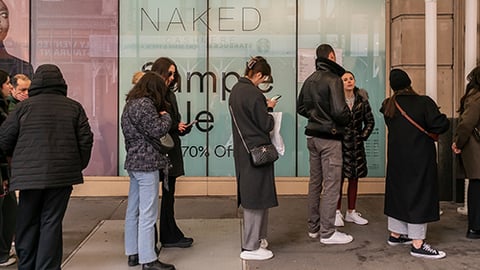Design to shine
Pharmacies offer vital healthcare services, but they aren’t known for exciting interiors. So, adding a dynamic look to physical stores seems like an obvious strategy for winning back customers lost to competition online and concept stores that offer many of the same products.
But there’s little talk of a wide-scale redesign of U.S. drug stores amid closings: Though Rite Aid announced a store-of-the-future concept in 2020, it filed for bankruptcy and began selling stores in October 2023. CVS, which bought Target’s pharmacy business less than 10 years ago, announced in January it will shutter a chunk of those in-store locations. Meanwhile, Walgreens Boots Alliance announced in June 2023 it would close 150 U.S. locations and 300 in the United Kingdom, moves that its then-CEO Rosalind Brewer described as “actions to optimize profitability for our U.S. healthcare segment.”
As simple as it sounds, stronger interior design concepts can help lure customers back, especially as traditional pharmacies are “poised for a transformative shift to becoming holistic healthcare hubs,” as Walgreens chief pharmacy officer Rick Gates told Drug Store News. That’s a bold departure from previous norms, and toward a consumer experience, which is a high concept. And high concepts call for complex spatial design.
[Read more: How collaboration and technology are improving health in communities]
Overseas, some pharmacies and beauty retailers are early adopters of that thinking, with good results. In 2010, French drug store MaPharmacie (My Pharmacy) differentiated itself as a purveyor of natural remedies with a conceptual interior by designer José Lévy in one location that abstracted the traditional French pharmacy symbol, a green cross. Lévy reinterpreted it in a lush-looking artificial plant wall behind the medicine counter, green marble floors and green neon signs. In mirrored shelves, customers can also see themselves reflected as part of the store. The chain now has 20 locations.
Likewise, wildly popular Melbourne-founded skin care company Aesop has made high-end interior design part of its brand and a vehicle for memorable customer experiences. Each location is by a different outside design team on its long global list, including a redesign just completed at the Georgetown store by Houston-based architect Daimian Hines.
“Their retail spaces always reference the typology of the community,” Hines explained. “We, as architects, tie that into some sensibilities of the company, such as nature. What you’re left with is a curated, defined designed space.” This is known as placemaking, and experts agree that it is key to pharmacies’ survival in the new wellness, beauty and health marketplaces.
Design Eyes
Retailers in other sectors have long made the connection that design has to marketing, branding and revenue generation (think Apple, Aesop or Nespresso). The right retail design is an essential part of who/what a brand is or what it wants to project to the world. Additionally, retail design is essentially about the users–a.k.a., customers.
“Store layouts must now allow for a seamless navigation from product discovery to purchase, but also enable value-add points of engagements that create enriching shopping experiences,” Forbes wrote last year.
In recent years, major outlets have undergone new store design that is intended to improve the customer experience.
Last year, Walmart celebrated the re-grand opening of 117 remodeled stores across the country, an investment of more than half a billion dollars in 30 states. “Each store is designed to deliver a more modern shopping experience and improve the lives of our associates and customers from the moment they step into the new space,” the retailer said. The goal is simple: to meet customers wherever they are, leveraging the stores to welcome people to a more modern, highly-connected Walmart.
Ulta Beauty also has rolled out a new store layout that integrates prestige brands with mass offerings. Chief Merchandising Officer Monica Arnaudo told the Retail Dive that the new layout is less about mixing mass with prestige, and more about improved navigation and creating spaces to discover.
“One of the things that was really important for us is to improve the navigation in the stores so that when a guest is looking for skincare, for example, they don’t need to go all around the store to find it,” Arnaudo told Retail Dive. Aesop, an Australian luxury cosmetics brand with a global following, has become known for its high-end interior design that is now part of its identity. As a result, each of its slick locations is by a different outside design team on its long global list.
Finally, in 2022, Target announced the next evolution of its new store strategy and store design to better serve its guests and team members and drive continued growth. The retailer’s new larger-format stores are nearly 150,000 square feet (20,000 square feet larger than the chain average) and offer a more open layout and localized elements to inspire and serve its guests.
“Target’s stores are at the heart of how we deliver for our guests, whether they browse the aisles, shop online or stop by for same-day services like Order Pickup and Drive Up,” said John Mulligan, executive vice president and chief operating officer, Target. “Guests and team members tell us they come to Target because they feel inspired, connected and welcomed. With our reimagined store design and larger store footprint that better supports our same-day services, we can give guests more of what they love while incorporating features that build on our commitment to sustainability, community and helping all families discover the joy of everyday life.”
“One thing I remember growing up in Virginia was getting to go to CVS and spend some of my allowance on a pack of gum, lip gloss or little toy,” says Lara Marrero, a principal and retail and consumer experience leader in London for global architecture firm Gensler. “Now pharmacies are kind of in this weird space . . . . [They are] mega-pharmacies, where you’ve got beauty products, convenience [items] and homewares or even grocery—kind of a hybrid between a pharmacy and a big box retailer. What the consumer-experience proposition settles on is really understanding the purpose of a place and having a strategic design approach for that specific location. When you understand the ‘why’ behind a place, [meaning] what it is the brand is trying to do in that particular location within the brand fleet.”
That kind of deeply visual interpretation of how customer engagement looks in a modern drug store is likely an unfamiliar consideration at chains used to focusing on delivering health care, dispensing, product displays and signage.
That’s one reason why third-generation-owned pharmacy Molecure in Taiwan hired Waterfrom Design in 2017 to bring its physical store into the 21st century.
As in the French drug store, a non-traditional material palette served as the place-making device here: Waterfrom’s intervention of transparent, acrylic display cases, white pebble-clad walls and a wood dispensing counter carved from 100-year-old tree captured the brand’s regional connection to its 1,300-square-foot location.
[Read more: Retail pharmacy searches for its top model]
Similarly, the brief for Hines’s Aesop renovation (which he couldn’t share in detail at the time this was reported) was for something business, muted by online drug sales that now total more than $52 billion in the United States. “[These chains] have an existential issue, and it is that the online U.S. pharmacy market is growing at over 11% a year. If I was a drug store, I’d be very concerned how online [competitors] will disrupt my business.”
Addressing that specific concern is where Gates’s prediction of healthcare hubs comes into play. “If you’re a mass retailer, one certainty in life is that you’re not going to have as many stores as you do at the moment,” says Ibrahim. But they will always have some physical locations, and it will be critical to make smart decisions about where and how those remaining stores will be used.
Ibrahim’s new notion of a physical space suggests that those precious few stores will shift from being transition and fulfillment platforms (places to buy and pickup drugs) to becoming two things: one, a media platform for health care, telemedicine and brand promotions; and two, community hubs for groups who share a particular interest in the brand or a wellness topic.
The scenario could work something like this, says Ibrahim: “With remote video consultation with doctors, why shouldn’t a drug store become a pod where you can book an appointment to talk to your doctor and pick up the drugs they just prescribed to you there in the pharmacy? We’re moving away from products for sale to the store as a ‘stage’ for putting on experiences.”
But these new third spaces still leave chains with buildings, the success of which depends more than ever on dynamic interior design. “Once we have that wow moment, we are chasing the next one,” says Marrero. “As we stop looking at a store as a simple, physical, density-driven experience, and look at it as a place for brands to connect with people, it changes that purpose of place.”
Certainly, big pharmacy chains have noticed a gap between their in-store experiences and consumers’ expectations, but are they more open when it comes to using truly creative interior design?
“Gensler has worked with people in this space from beauty brands to pharmacies to big box retailers,” Marrero says. “I believe they do understand the importance of creating that connection and they are seeking partners to help them solve for these experiences.” After all, good design is good business.





